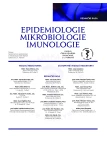West Nile virus (lineage 2) detected for the first time in mosquitoes in Southern Bohemia: new WNV endemic area?
Authors:
I. Rudolf 1
; F. Rettich 2; L. Betášová 1; K. Imrichová 2; J. Mendel 1
; Z. Hubálek 1
; S. Šikutová 1
Authors‘ workplace:
Ústav biologie obratlovců AV ČR, v. v. i., Brno
1; Státní zdravotní ústav, Praha
2
Published in:
Epidemiol. Mikrobiol. Imunol. 68, 2019, č. 3, s. 150-153
Category:
Short Communication
Overview
Here we report the first detection of lineage 2 of neuroinvasive West Nile virus (WNV-2) in mosquitoes collected in a fishpond area of the Trebon Basin in southern Bohemia during the 2018 mosquito season. A total of 6790 mosquito females belonging to the Culex modestus, Culex pipiens, and Coquillettidia richiardii species were investigated in 136 pools, and WNV RNA was detected in two of them. The WNV strain shares genetic homology with other WNV-2 strains isolated in southern Moravia as well as with those causing outbreaks in southern and central Europe. The results highlight the need for entomological surveillance of pathogenic arboviruses even in areas not yet affected (WNV-free areas). The South Bohemian Region (in addition to southern Moravia) is becoming another risk zone of autochthonous occurrence of West Nile fever in the Czech Republic.
Keywords:
West Nile virus – arboviruses – emerging zoonoses – Mosquitoes – South Bohemia – Culex modestus – Culex pipiens – Coquillettidia richiardii
Sources
1. Hubálek Z, Rudolf I. Microbial Zoonoses and Sapronoses. Dordrecht: Springer;2011.
2. Hernández-Triana LM, Jeffries CL, Mansfield KL, et al. Emergence of West Nile virus lineage 2 in Europe: a review on the introduction and spread of a mosquito-borne disease. Front Public Health, 2014;2 : 271.
3. Hubálek Z, Halouzka J, Juřicová Z. West Nile fever in Czechland. Emerg Infect Dis, 1999; 5 : 594-595.
4. Bakonyi T, Hubálek Z, Rudolf I, et al. Novel flavivirus or new lineage of West Nile virus, Central Europe. Emerg Infect Dis, 2005;1 : 225-231.
5. Hubálek Z, Halouzka J, Juřicová Z, et al. Serologic survey of birds for West Nile flavivirus in southern Moravia (Czech Republic). Vector-borne Zoonot Dis, 2008;8 : 659−666.
6. Sedlák K, Zelená H, Křivda V, et al. Surveillance západonilské horečky u koní v České republice v letech 2011-2013. Epidemiol Mikrobiol Imunol, 2014;63 : 307-311.
7. Hubálek Z, Juřicová Z, Straková P, et al. Serological survey for West Nile virus in wild artiodactyls, Southern Moravia (Czech Republic). Vector-borne Zoonot Dis, 2017;17 : 654-657.
8. Rudolf I, Bakonyi T, Šebesta O, et al. West Nile virus lineage 2 isolated from Culex modestus mosquitoes in the Czech Republic, 2013: expansion of the European WNV endemic area to the North? Euro Surveill, 2014;19 (31):pii=20867.
9. Rudolf I, Betášová L, Blažejová H, et al. West Nile virus in overwintering mosquitoes, Central Europe. Parasites & Vectors, 2017;10 : 452.
10. Rudolf I, Blažejová H, Šebesta O, et al. West Nile virus (lineage 2) in mosquitoes in southern Moravia - awaiting the first autochthonous human cases. Epidemiol Mikrobiol Imunol, 2018; 647 : 44-46.
11. ECDC. Epidemiological update: West Nile virus transmission season in Europe. 2018. Dostupné na www: www.ecdc.europa.eu/en/west-nile-fever/surveillance-and-disease-data/disease-data-ecdc.
12. Šebesta O, Gelbič I, Peško J. Daily and seasonal variation in the activity of potential vector mosquitoes. Cent Eur J Biol, 2011;6 : 422-430.
13. Becker N, Petrič D, Zgomba M, et al. Mosquitoes and their control. Heidelberg: Springer; 2010.
14. Vlčková J, Rupeš V, Horáková D, et al. Rizika šíření viru západonilské horečky v České republice. Epidemiol Mikrobiol Imunol, 2015;64 : 80-86.
15. ECDC. 2013. West Nile virus risk assesment tool. 2013. Dostupné na www: www.ecdc.europa.eu/en/publications-data/west-nile-virus-risk-assessment-tool-0.
16. European Commission. West Nile Virus and Blood Safety – Introduction to a preparedness plan in Europe 2012. Based on the EU Satellite Meeting of the Working Group on Blood Safety and WNV, Thessaloniki, 25-26 January 2011 – and on the teleconference, 18 January 2012. Final Working Document 2012 v.2.1. Prepared by: Greece, Italy, Romania and France – 6 June 2012. Dostupné na www: https://ec.europa.eu/health/sites/health/files/blood_tissues_organs/docs/wnv_preparedness_plan_2012.pdf.
Labels
Hygiene and epidemiology Medical virology Clinical microbiologyArticle was published in
Epidemiology, Microbiology, Immunology

2019 Issue 3
Most read in this issue
- Incidence and analysis of campylobacteriosis cases in the Czech Republic in 1997–2017
- Prevalence and the role of CCR5Δ32 heterozygosity in disease progression in HIV positive patients in the Czech Republic
- Antiviral adoptive immunotherapy using antigen-specific T cells in allogeneic hematopoietic stem cell transplant recipients
- A high prevalence of viral hepatitis C in a socially excluded Roma community in Brno
